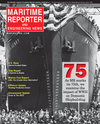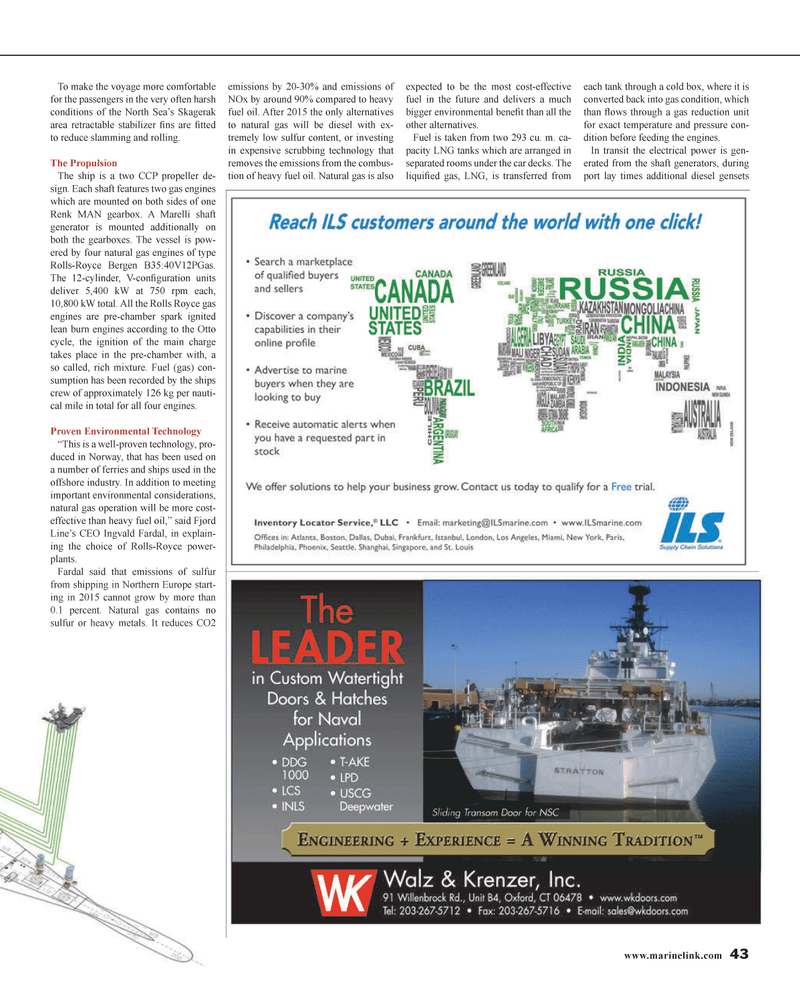
Page 43: of Maritime Reporter Magazine (January 2014)
Ship Repair & Conversion Edition
Read this page in Pdf, Flash or Html5 edition of January 2014 Maritime Reporter Magazine
www.marinelink.com 43
To make the voyage more comfortable for the passengers in the very often harsh conditions of the North Sea’s Skagerak area retractable stabilizer fi ns are fi tted to reduce slamming and rolling.
The Propulsion
The ship is a two CCP propeller de- sign. Each shaft features two gas engines which are mounted on both sides of one
Renk MAN gearbox. A Marelli shaft generator is mounted additionally on both the gearboxes. The vessel is pow- ered by four natural gas engines of type
Rolls-Royce Bergen B35:40V12PGas.
The 12-cylinder, V-confi guration units deliver 5,400 kW at 750 rpm each, 10,800 kW total. All the Rolls Royce gas engines are pre-chamber spark ignited lean burn engines according to the Otto cycle, the ignition of the main charge takes place in the pre-chamber with, a so called, rich mixture. Fuel (gas) con- sumption has been recorded by the ships crew of approximately 126 kg per nauti- cal mile in total for all four engines.
Proven Environmental Technology “This is a well-proven technology, pro- duced in Norway, that has been used on a number of ferries and ships used in the offshore industry. In addition to meeting important environmental considerations, natural gas operation will be more cost- effective than heavy fuel oil,” said Fjord
Line’s CEO Ingvald Fardal, in explain- ing the choice of Rolls-Royce power- plants.
Fardal said that emissions of sulfur from shipping in Northern Europe start- ing in 2015 cannot grow by more than 0.1 percent. Natural gas contains no sulfur or heavy metals. It reduces CO2 emissions by 20-30% and emissions of
NOx by around 90% compared to heavy fuel oil. After 2015 the only alternatives to natural gas will be diesel with ex- tremely low sulfur content, or investing in expensive scrubbing technology that removes the emissions from the combus- tion of heavy fuel oil. Natural gas is also expected to be the most cost-effective fuel in the future and delivers a much bigger environmental benefi t than all the other alternatives.
Fuel is taken from two 293 cu. m. ca- pacity LNG tanks which are arranged in separated rooms under the car decks. The liquifi ed gas, LNG, is transferred from each tank through a cold box, where it is converted back into gas condition, which than fl ows through a gas reduction unit for exact temperature and pressure con- dition before feeding the engines.
In transit the electrical power is gen- erated from the shaft generators, during port lay times additional diesel gensets
MR #1 (42-49).indd 43 1/7/2014 11:24:53 AM

 42
42

 44
44
